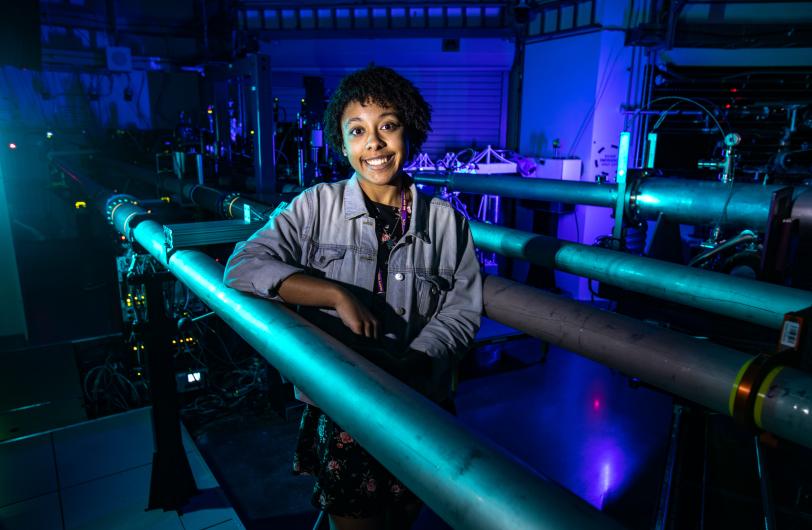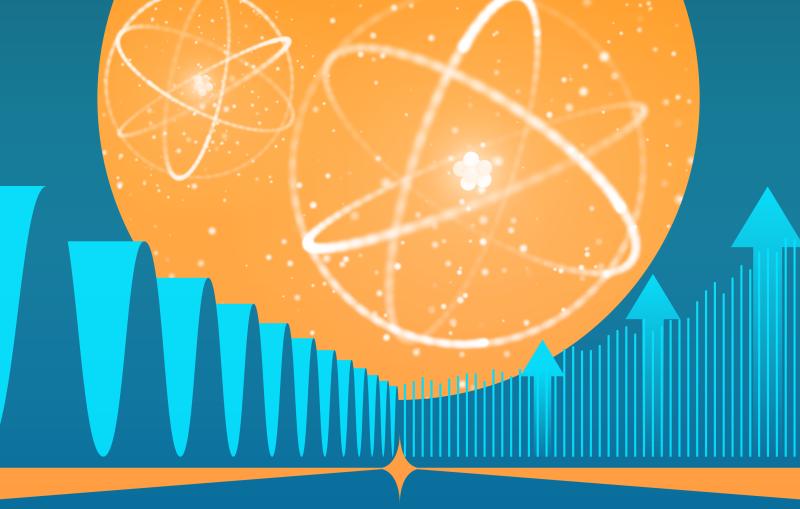A day in the life of an experiment controls engineer
By tinkering and troubleshooting, Aalayah Spencer helps turn researchers’ ideas into state-of-the-art science experiments.
By Isabel Swafford
When a scientist at the Linac Coherent Light Source (LCLS) has an idea for a new experiment, Aalayah Spencer helps make their dreams a reality.
Spencer is a science and engineering associate in Experiment Control Systems at the Department of Energy’s SLAC National Accelerator Laboratory, and along with her fellow engineers, she designs, tests, implements, codes, and troubleshoots a wide variety of technologies scientists deploy at LCLS. And when a new idea comes along, Spencer and her fellow engineers meet with scientists to hash out the specifics and then get to tinkering.
“We make magic,” Spencer says. “We make things work. That goes for anything from high voltage systems to Python scripts, cameras, motion stages, syringe pumps, and interactive screens.”

A bathroom chemist
For Spencer, the magic began early on.
“Math and science have always been in my brain,” she says.
Spencer was an inquisitive child, and her mom thought she might become a chemist because she was always in the bathroom concocting cocktails out of oil, soap or baby powder.
“As I got older, I fell in love with the universe and seeing how everything worked,” she says. She even dreamed of becoming an astronaut.
Although she didn’t have many role models around her, Spencer always felt like she belonged in a career in science. Her mom would buy her math and science books and support her work in her high school robotics club.
“I was fortunate enough to have parents that helped me to grow my skills and allowed me to find my love of math and science. I was never hindered in what I wanted to know,” she says.
That support helped lead her to Michigan State University, where Spencer got her bachelor’s degree in astrophysics. She was fascinated by the nuclear fusion that fuels stars and worked on nuclear astrophysics projects at the National Superconducting Cyclotron Laboratory in Michigan and high-temperature materials science at the National Centre for Scientific Research in France.
Spencer also volunteered at science outreach events hosted by her lab to inspire future scientists and act as a role model for young students like herself.
“At science days I helped kids with experiments and showed them that we smash particles together,” she says. “Volunteering allowed me to talk to a lot of different people about science, get to know my peers in the lab and bring positivity to work.”
From fiery hot stars to warmer climates
Meanwhile, she said, she also discovered a love for coding. Inspired by that passion and fond memories from her high school robotics club, Spencer applied to be a control systems engineer at SLAC after graduating from college.
She got the job, and now Spencer gets to help scientists at all stages of an experiment. Since she started in January 2021, Spencer has worked on a variety of instruments at LCLS including the hard X-ray single-shot spectrometer, the X-ray pump-probe, the X-ray correlation spectroscopy instrument and the time-resolved atomic, molecular and optical science instrument, among others.
As her work has progressed, Spencer has gotten to do more and more coding in addition to hardware jobs, adding new skills to her repertoire.
“Software work has become one of my favorite parts of my job. I really like coding. It's cool to make things work through code and software,” she says. “My position allows me to learn different things and to grow my skills in what I want to know.”
Some of the best aspects of her job, Spencer says, are the opportunities to collaborate with scientists of various expertise areas and delve into all the different steps of the scientific process.
“I am getting more comfortable with asking the scientists ‘why?’ Why am I doing this? It's important to know how everything could affect the experiment that's about to happen,” Spencer says.
Coworkers turned friends
At work, Spencer can usually be found listening to electronic dance music. “I have to listen to music when I work. It's what gets my mind focused. Especially when I'm coding," she says.
Outside of work, Spencer enjoys watching movies, playing video games like Halo or Minecraft and spending time with her dog Abu, a tiny poodle mix. Spencer is also a fan of extreme road trips. She drove all the way from her home state of Michigan to California when she moved for her new job and is preparing to do it again when her mom moves here in the next few weeks.
For weekend brunch, she and her coworkers like to hit up the Palo Alto spot Local Union 271 for waffles or an eggs benedict.
“My coworkers have become my friends,” she says. Although she works from home occasionally, she comes on site to help with experimental setups and be with people she likes to talk to. “Being able to work around that positivity helps with my morale and my productivity.”
A graduate of the class of 2020, Spencer is still early in her career as an engineer, but she has advice for other early-career scientists and engineers: Keep learning.
“You never know when you're going to come across something you'll need in the future. If you're constantly trying to learn different things, not just scientific concepts, like a reading new book or learning the style of a new author, it keeps you sharp.”
As for future career goals, Spencer says that her dream of being an astronaut isn’t out of the picture. “It's still in the works.”
For questions or comments, contact the SLAC Office of Communications at communications@slac.stanford.edu.
About SLAC
SLAC National Accelerator Laboratory explores how the universe works at the biggest, smallest and fastest scales and invents powerful tools used by researchers around the globe. As world leaders in ultrafast science and bold explorers of the physics of the universe, we forge new ground in understanding our origins and building a healthier and more sustainable future. Our discovery and innovation help develop new materials and chemical processes and open unprecedented views of the cosmos and life’s most delicate machinery. Building on more than 60 years of visionary research, we help shape the future by advancing areas such as quantum technology, scientific computing and the development of next-generation accelerators.
SLAC is operated by Stanford University for the U.S. Department of Energy’s Office of Science. The Office of Science is the single largest supporter of basic research in the physical sciences in the United States and is working to address some of the most pressing challenges of our time.





